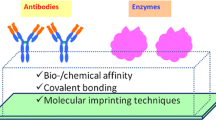Abstract
Antibody immobilization onto solid surface has been studied extensively for a number of applications including immunoassays, biosensors, and affinity chromatography. For most applications, a critical consideration regarding immobilization of antibody is orientation of its antigen-binding site with respect to the surface. We compared two oriented antibody immobilization strategies which utilize thiolated-protein A/G and thiolated-secondary antibody as linker molecules with the case of direct surface immobilization of thiol-conjugated target antibody. Antibody immobilization degree and surface topography were evaluated by surface plasmon resonance and atomic force microscope, respectively. Protein A/G-mediated immobilization strategy showed the best result and secondary antibody-mediated immobilization was the worst for the total immobilization levels of target antibodies. However, when considering real-to-ideal ratio for antigen binding, total target antigen binding levels (oriented target antibody immobilization levels) had the following order: secondary antibody-mediated immobilization>protein A/G-mediated immobilization>direct thiol-conjugated immobilization. Thus, we confirmed that protein A/G- and secondary antibody-mediated strategies, which consider orientation of target antibody immobilization, showed significantly high antigen binding efficiencies compared to direct random immobilization method. Collectively, the oriented antibody immobilization methods using linker materials could be useful in diverse antibody-antigen interaction-involved application fields.
Similar content being viewed by others
References
A.G. Richard, J. K. Thomas, A. O. Barbara and K. Janis, Immunology, New York (2002).
D. S. Aga and E. M. Thurman, Immunochemical technology for environmental applications, Amer. Chem. Soc. Symp., 657, 1 (1996).
H. X. You, D. M. Disley, D. C. Cullen and C. R. Lowe, Micron, 26, 121 (1995).
D. S. Hage, Anal. Chem., 67, 455 (1995).
B. Lu, M. R. Smyth and R. Okennedy, Analyst, 121, 29 (1996).
T. M. Spitznagel and D. S. Clark, Biotechnology, 11, 825 (1993).
S. Kaku, S. Nakanishi and K. Horiguchi, Anal. Chim. Acta, 225, 283 (1989).
G. T. Hermanson, Bioconjugate techniques, Academic Press, CA (1996).
H. Zhu and M. Synder, Curr. Opin. Chem. Biol., 7, 55 (2003).
R. F. Taylor, Protein Immobilization, New York (1990).
C. Suárez-Pantaléon, J. Wichers, A. Abad-Somovilla, A. van Amerongen and A. Abad-Fuentes, Biosens. Bioelectron., 42, 170 (2013).
F. Caruso, E. Rodda and D. N. Furlong, J. Colloid Interface Sci., 178, 104 (1996).
M. Steinitz, Anal. Biochem., 282, 232 (2000).
R. R. Traut, A. Bollen, T. T. Sun, J.W. Hershey, J. Sundberg and L. R. Pierce, Biochemistry, 12 (1973).
W. D. Sikkema, An Fc-binding protein, Amer. Biotech. Lab., 7, 42 (1989).
Y. M. Bae, B.K. Oh, W. Lee, W. H. Lee and J.W. Choi, Biosens. Bioelectron., 21, 103 (2005).
E. H. Alfred, J. Immunol., 37, 77 (1939).
A. P. Quist, A. A. Bergman, C. T. Reimann, S. O. Oscarsson and B. U. R. Sundqvist, Scanning Microsc., 9, 395 (1995).
A. San Paulo and R. Garcia, Biophys. J., 78, 1599 (2000).
Author information
Authors and Affiliations
Corresponding author
Additional information
Equal contribution
Rights and permissions
About this article
Cite this article
Lee, J.E., Seo, J.H., Kim, C.S. et al. A comparative study on antibody immobilization strategies onto solid surface. Korean J. Chem. Eng. 30, 1934–1938 (2013). https://doi.org/10.1007/s11814-013-0117-5
Received:
Accepted:
Published:
Issue Date:
DOI: https://doi.org/10.1007/s11814-013-0117-5




